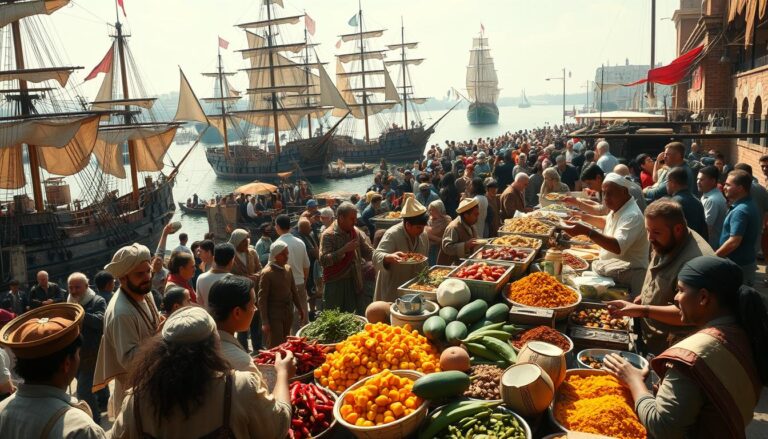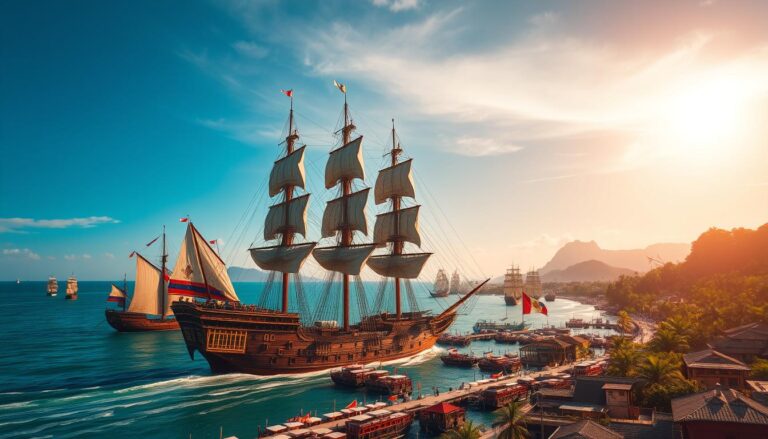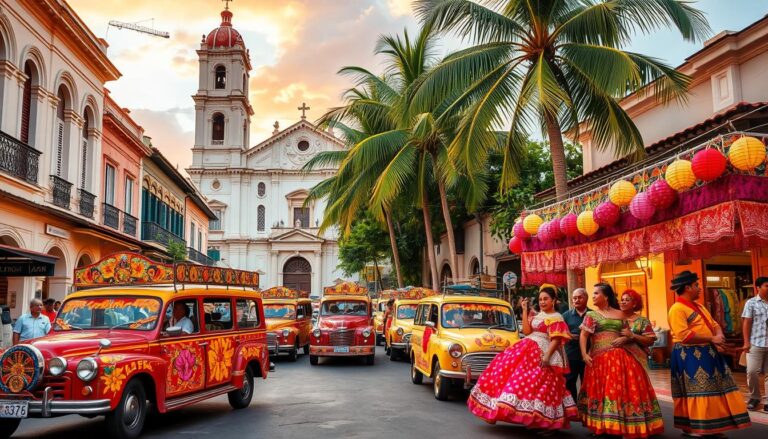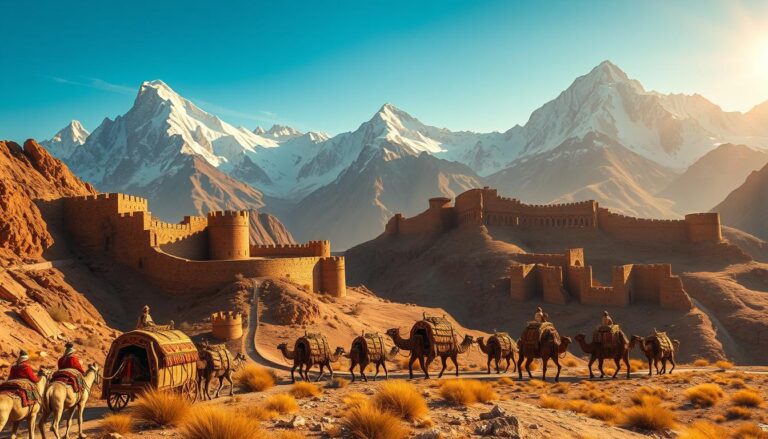American Colonization Philippines: A Historical Overview
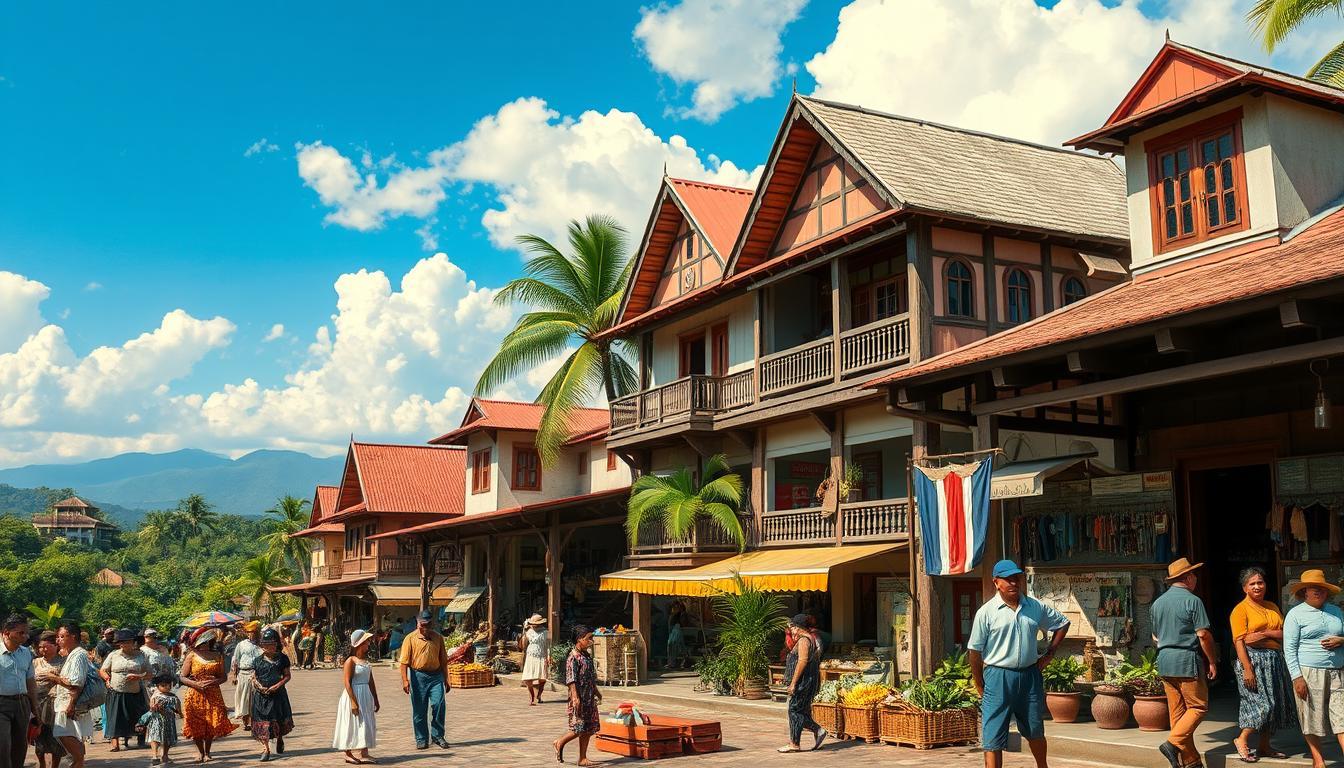
Did you know over 200,000 Filipino civilians died from violence, famine, and disease in the Philippine-American War? This shows the deep impact of colonization and the tragic effects of American rule in the Philippines. The period of American rule lasted from 1898 to 1946, changing the Philippines’ politics, society, and culture.
Understanding this time is key to knowing the Filipino identity and the changing ties between the Philippines and the United States.
Key Takeaways
- The Philippine-American War resulted in profound civilian suffering.
- The conflict transformed from conventional warfare to guerrilla tactics.
- American governance initiated social and infrastructure reforms in the Philippines.
- The establishment of a colonial government marked a shift in political structures.
- The journey towards Filipino independence began with the Jones Act of 1916.
- Public health crises spurred significant improvements in infrastructure and sanitation.
Introduction to American Colonization
The shift from Spanish to American rule was a big change for the Philippines. After Spain lost the Spanish-American War, the U.S. bought the Philippines for $20 million. This was in December 1898, starting a new era of governance.
Understanding why America colonized the Philippines is key. They wanted new markets for their goods. They also saw the Philippines as a strategic military base in Asia. Plus, they believed they could improve “lesser” cultures.
The takeover led to conflict, as Filipinos fought for their freedom. The Philippine-American War lasted from 1899 to 1902. It was bloody, with thousands of soldiers and civilians dying.
As the U.S. took control, they used a policy called “benevolent assimilation.” But Filipinos were skeptical. They saw the U.S. as just taking their resources and building bases. This shaped the U.S. rule in the Philippines.
The Spanish-American War and the Treaty of Paris
The Spanish-American War started on April 21, 1898. It was a key moment in Philippines history. The war began when the U.S. helped Cuba fight for freedom. It soon spread to the Philippines, leading to big battles.
The Battle of Manila Bay was a turning point. The U.S. Navy showed its strength, defeating the Spanish fleet. This victory was crucial for the U.S.
The war’s impact was huge. Over 80,000 American soldiers went to the Philippines. By 1901, there were 75,000 U.S. soldiers. Emilio Aguinaldo’s forces, with about 40,000 fighters, fought for Filipino freedom.
The war ended with the Treaty of Paris on December 10, 1898. Spain gave Guam, Puerto Rico, and the Philippines to the U.S. for $20 million. This made the U.S. a major power in the Pacific.
The U.S. Senate approved the treaty on February 6, 1899. It was a close vote, showing the debate over U.S. expansion.
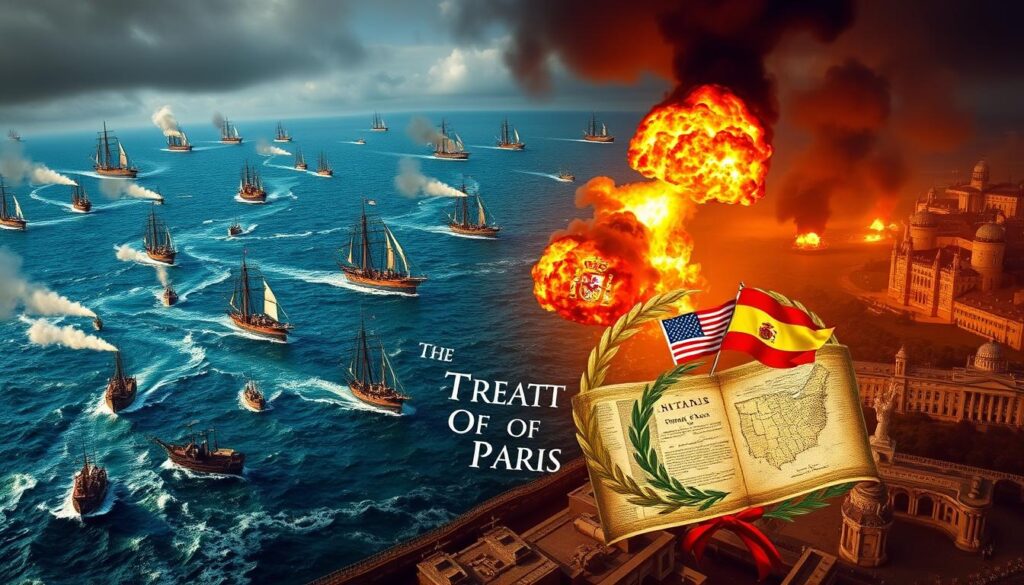
The Treaty of Paris had big effects. The U.S. became a major colonial power. It started a new era in U.S. rule in the Philippines. This also shaped the U.S.-Philippines relationship and the growth of Filipino identity.
Aftermath of the Treaty: Initial Reactions
The Treaty of Paris changed Philippine history a lot. After the treaty was ratified, people in the U.S. were mostly happy. But in the Philippines, many were upset, especially those who wanted freedom.
Leaders like Emilio Aguinaldo started to fight against the new rule. They saw it as just another form of control.
Filipino Resistance to American Rule
After the treaty, many Filipinos started to resist. They had fought with the Americans before but now felt let down. This led to a big movement for freedom.
People across the Philippines began to rise up. They were angry about the harsh rule and wanted to be free.
The Role of Emilio Aguinaldo
Emilio Aguinaldo was a key figure in the fight against the Americans. He declared the Philippine Republic on January 1, 1899. This made him a hero to many Filipinos.
On February 4, 1899, fighting started between the Philippines and the U.S. It was a long and bloody war. Over 20,000 Filipino fighters died in the fight for freedom.
| Event | Date | Description |
|---|---|---|
| Treaty of Paris Ceding Philippines | December 10, 1898 | Spain ceded the Philippines to the U.S. for $20 million. |
| Declaration of Philippine Republic | January 1, 1899 | Emilio Aguinaldo declared the independence of the Philippines. |
| Start of Philippine-American War | February 4, 1899 | Open conflict erupted after three Filipino soldiers were killed. |
| End of Hostilities | July 4, 1902 | Official end of hostilities proclaimed, but guerrilla warfare continued. |
The Philippine-American War: An Overview
The Philippine-American War was a key event in U.S.-Philippine relations. It was marked by fierce battles and had a big impact on the Filipino people. Understanding the war’s phases helps us see its complexity and the high number of casualties.
Phases of the War
The war had two main phases: conventional warfare and guerrilla warfare. The first phase started on February 4, 1899, when the U.S. took over from Spain. This sparked anger among Filipinos who wanted to be free.
The battles were often in cities, where Filipino forces attacked American troops. As the war went on, the Filipino fighters changed their tactics. They used guerrilla warfare, hitting and running, to keep fighting despite being outgunned.
Casualties and Impact
The war was very costly, with over 20,000 Filipino fighters and more than 4,200 American soldiers killed. The war’s toll wasn’t just on soldiers but also on civilians. Many people suffered from violence, hunger, and sickness as their homes were destroyed.
The war left deep scars on the Filipino people. The way prisoners were treated and the disrespect shown to the locals made things worse. The U.S. rule changed Filipino society and their dreams of freedom.
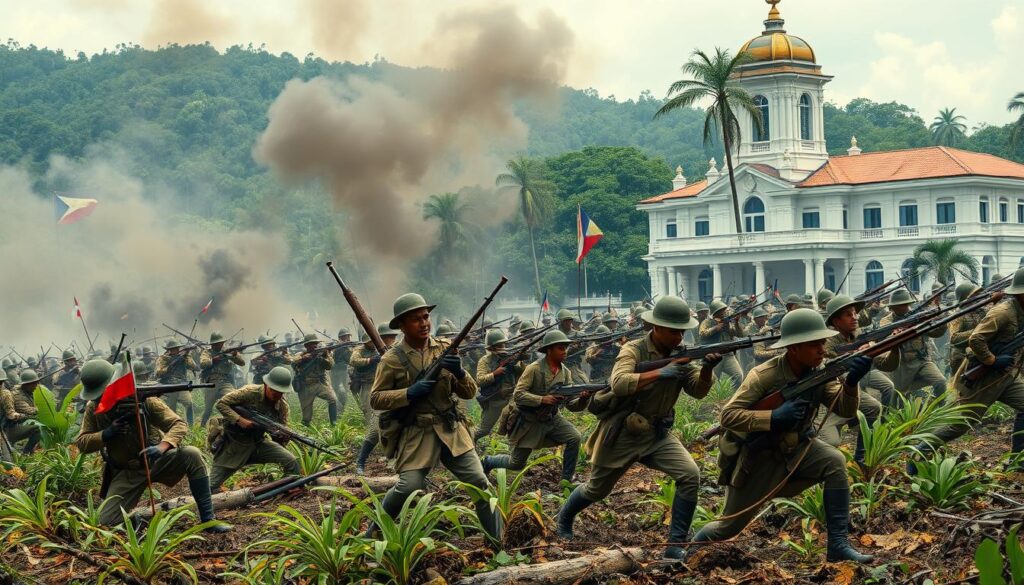
| Phase of Conflict | Description | Consequences |
|---|---|---|
| Conventional Warfare | Organized battles with traditional military strategies. | High visibility casualties and urban destruction. |
| Guerrilla Warfare | Asymmetric warfare tactics by Filipino nationalists. | Prolonged conflict and worsening conditions for civilians. |
Looking at the Philippine-American War helps us understand the lasting effects of colonization and conflict. These effects have shaped Filipino society for many years.
Benevolent Assimilation: America’s Colonial Policy
President William McKinley introduced the policy of Benevolent Assimilation on December 21, 1898. This move came after the Treaty of Paris ended the Spanish-American War. McKinley wanted to bring American governance to the Philippines with kindness, believing it would educate and civilize the people.
This policy aimed to gain the trust of the Filipino people by promising them rights and freedoms. Yet, it caused confusion and discontent among many Filipinos. They worried that terms like “sovereignty” and “protection” meant future control by the U.S.

General Elwell Otis was key in spreading this policy, sending a toned-down version of McKinley’s message to Emilio Aguinaldo. The changes were made to show American kindness and avoid upsetting Filipinos. But, they also showed a concern about how both educated and uneducated Filipinos would see U.S. goals.
The events that followed this message were crucial in the Philippine-American War, lasting from 1899 to 1903. The effects of Benevolent Assimilation policy showed the challenges of colonial rule and the fight for Filipino rights. It also showed how American policies deeply influenced the Philippines’ politics and society during that time.
Insular Cases: Legal Precedents Established
The Insular Cases, a series of Supreme Court decisions from 1901, changed how American law applies to U.S. territories gained during the Spanish-American War. These cases set key legal rules for the rights of people living in places like the Philippines.
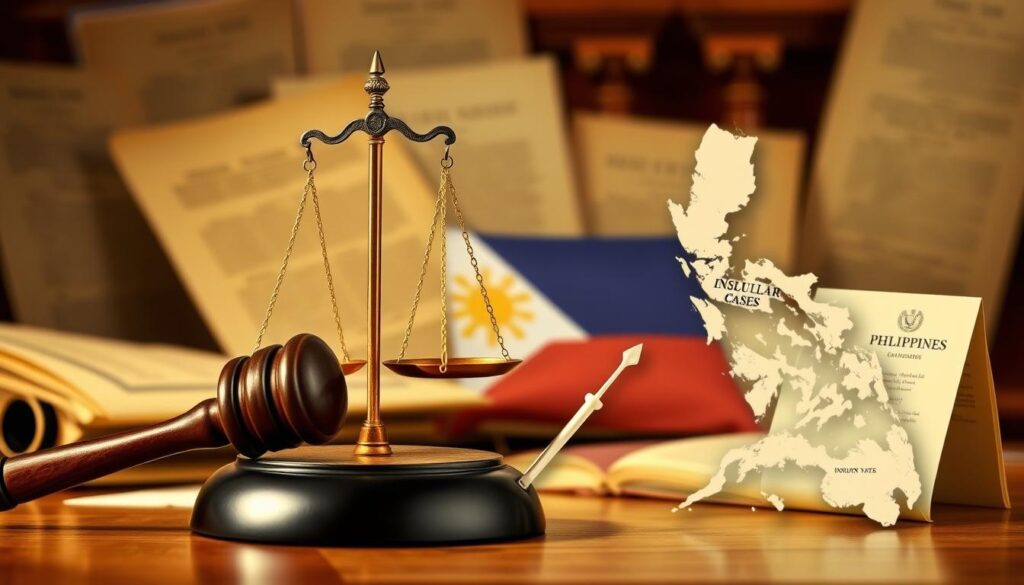
The core idea was the doctrine of territorial incorporation. This idea split territories into two groups. Incorporated areas, like Alaska and Hawaii, follow the Constitution fully. Unincorporated places, like Puerto Rico and Guam, have limited constitutional rights. Critics say these decisions were based on racial biases, calling people in these areas “alien races” and “savage tribes.”
There were six main cases in the Insular Cases, all from 1901. Scholars have added more cases, even up to 1979. Important cases like Hawaii v. Mankichi (1903) and Balzac v. Porto Rico (1922) still shape talks on colonial rule and rights.
These legal rules have shaped the lives of about 3.5 million people in unincorporated territories. A bill introduced in April 2023 by Rep. Raúl M. Grijalva aims to reverse the Insular Cases. It shows the ongoing debate over territory status and representation.
| Case Name | Date Decided | Key Decision |
|---|---|---|
| Downes v. Bidwell | 1901 | Constitution does not automatically apply to unincorporated territories. |
| Hawaii v. Mankichi | 1903 | Classification of Hawaii’s territorial status. |
| Balzac v. Porto Rico | 1922 | Ruling on the application of constitutional provisions in Puerto Rico. |
| Additional Cases | Up to 1979 | Inclusion of territories and extended interpretations. |
Understanding the Insular Cases is still important today. They affect talks on citizenship, civil rights, and the status of territories in American governance.
Filipino Nationalism During American Rule
Filipino nationalism grew a lot during American rule. Many nationalist movements started, showing a strong wish for freedom. These movements showed the deep desire for a country to be its own.
Rise of Nationalist Movements
When Americans took over, many groups fought back. They wanted their rights and freedom. This led to groups pushing for their voices to be heard and for fair treatment.
- Katipunan: Started before American rule, it was key in the fight against Spain.
- Liberal Party: It pushed for big changes in the country.
- Democratic Party: It wanted Filipinos to lead, not Americans.
Key Figures in Filipino Nationalism
Important leaders played big roles in this fight for freedom. Their work is key to understanding the quest for independence.
| Name | Role | Contributions |
|---|---|---|
| Emilio Aguinaldo | Revolutionary Leader | He declared the Philippines free on June 12, 1898, and fought against the Americans. |
| Andres Bonifacio | Revolutionary Figure | He started the Katipunan, sparking the fight against Spanish and American rule. |
| José Rizal | Nationalist and Reformer | His writings inspired many Filipinos and spoke out against unfair colonial rule. |
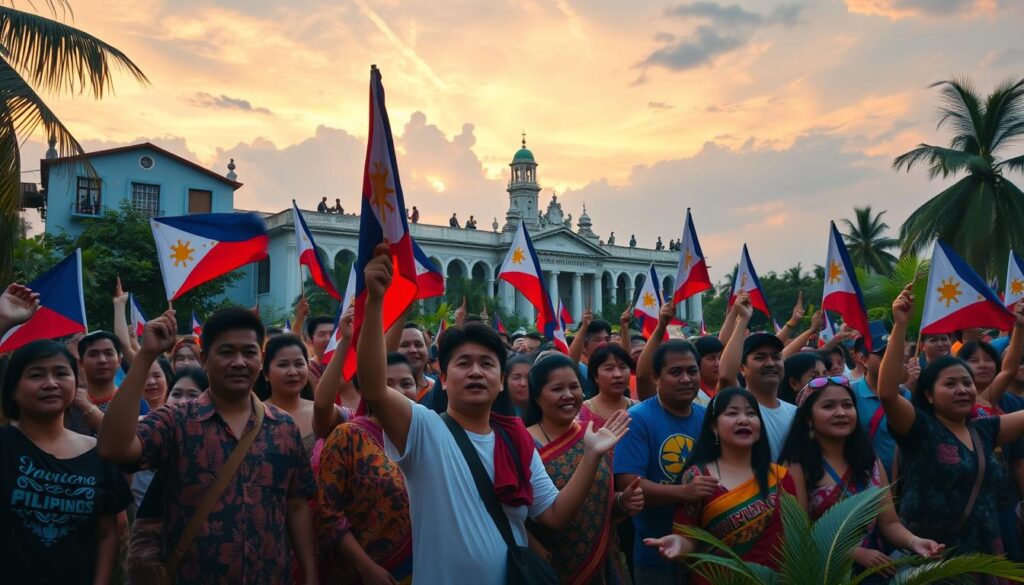
These leaders were crucial in uniting Filipinos. They set the stage for future fights for freedom. Their ideas greatly shaped the country’s politics and its story of seeking independence.
Americanization of the Philippines
The Americanization of the Philippines was a big change. It brought new programs to change Filipino society. These programs focused on education and building new things, like roads and schools.
They wanted to make the Philippines more like America. This included teaching American values and how to govern. These changes were seen in many parts of Filipino life.
Education System Reforms
Education was a big part of the Americanization. The U.S. opened around 10,000 schools from 1903 to 1940. This number grew to 13,000, making more people literate and English-speaking.
- Filipino students learned about American heroes, democracy, and individualism.
- Celebration of American holidays, such as the Fourth of July, became integrated into school culture.
- Over time, curriculum adjustments included Filipino culture, national heroes, folk dances, and art.
- By 1939, approximately one-fourth of the population spoke English, promoting a common linguistic foundation.
These changes made education more like America’s. They also helped Filipinos feel more national pride. This was a big cultural shift.
Infrastructure Development
Building new things was also key. The U.S. spent a lot on roads, bridges, and buildings. This changed the look of the Philippines.
| Infrastructure Projects | Description | Impact |
|---|---|---|
| Roads | Extensive road networks were established to connect major towns and cities. | Increased trade and accessibility for rural communities. |
| Bridges | Construction of bridges improved transportation across archipelagic terrains. | Enhanced movement of goods and people, contributing to economic integration. |
| Public Buildings | New schools, hospitals, and government buildings were erected in urban areas. | Enhanced public health and facilitated governance and education. |
The focus on building things helped the economy grow. It also changed how people lived and interacted. These changes are still seen today.
Philippine Resistance and Anti-Colonial Movements
The fight for freedom during American rule was filled with resistance from the Philippines. Filipinos showed great resilience through organized movements and uprisings. Places like Batangas, Luzon, Mindanao, and Samar were hotspots of resistance, with both Filipino and American forces involved.
The Philippine-American War lasted from February 4, 1899, to July 4, 1902. It started near Manila and saw Filipinos face off against the U.S. military. The war was brutal, with estimates suggesting up to 250,000 Filipino civilians died.
The Battle of Manila was a turning point. On August 13, American troops took Manila, but it was a bloodless victory. Yet, most of the Philippines remained under Filipino control. This showed the ongoing fight for independence.
To understand the impact of these movements, consider the table below, showcasing key elements of the conflicts during this volatile era:
| Event | Date | Location | Outcome |
|---|---|---|---|
| Start of the Philippine-American War | February 4, 1899 | Outskirts of Manila | U.S. Victory |
| Battle of Manila | August 13, 1898 | Manila | American Control Established |
| End of the Philippine-American War | July 4, 1902 | Philippines | U.S. Governance Solidified |
Anti-colonial feelings were not just in the Philippines but also in America. A growing anti-imperialism movement emerged in the U.S. The desire for freedom fueled the resistance, showing Filipinos’ strong wish for self-rule.
Establishment of the Philippine Commonwealth
The Philippine Commonwealth was formed in 1935, marking a key step towards the country’s freedom. This period moved away from American rule towards a system that empowered Filipinos. It still kept U.S. oversight, though.
Significance of the Jones Act
The Jones Act, also known as the Tydings-McDuffie Act of 1934, paved the way for this change. It promised Filipino independence in twelve years. Filipinos voted 96 percent for the Commonwealth’s constitution, showing their desire for self-rule.
Transition to Self-Government
The Commonwealth period brought a more organized government. It had a strong leader, a supreme court, and a two-chamber legislature. The Nacionalista Party dominated, aiming for better representation.
English, Spanish, and Tagalog were the official languages, showing the country’s diverse culture. Women’s suffrage was also introduced, allowing more women to participate in governance.
The economy recovered to pre-Depression levels before Japan invaded in 1941. Despite this, the Commonwealth laid important groundwork for the Philippines’ future. It shaped the country’s governance and politics until it gained full independence in 1946.
Impact of World War II on the Philippines
World War II changed the Philippines forever. The Japanese occupation from 1941 to 1945 was very hard on the people. About one million civilians died during this time.
The American forces came back in 1945. They were helped by around 100,000 Filipinos and 20,000 American soldiers. The Bataan Death March was a terrible event where many died.
In Manila, there were big battles that killed about 100,000 people. The rescue of 2,132 Allied prisoners in Los Baños also had a high cost. It showed how hard the war was.
The Philippines lost a lot during World War II. More than 15 million soldiers and 45 million civilians died worldwide. The Philippines had a big share of this loss.
The Philippines’ role in World War II is still important today. It shapes who the Filipinos are and their fight for freedom. The war’s effects are still felt, showing the strength and courage of the Filipino people.
The Road to Philippine Independence
To understand the Philippines’ path to freedom, we must look at key events. These events shaped the nation’s journey from being colonized to becoming independent. After World War II, Filipinos wanted freedom more than ever. Important events during this time helped pave the way for the Philippines to be recognized as a sovereign nation.
Key Events Leading to Independence
The journey to the Philippines’ freedom began with several major events:
- The Spanish-American War started in April 1898, making the U.S. in charge of the Philippines.
- On June 12, 1898, Emilio Aguinaldo declared the Philippines’ independence. But, this wasn’t recognized by the world.
- The Treaty of Paris was signed, giving the U.S. the Philippines for $20 million. This made the path to freedom even harder.
- The Philippine-American War lasted from 1899 to 1902. It caused a lot of deaths, more than in the Spanish-American War.
- In 1935, the Commonwealth of the Philippines was set up. This was a big step towards self-rule and full freedom.
Recognition of Independence in 1946
The Philippines finally gained its freedom on July 4, 1946. With World War II over, the U.S. recognized the Philippines’ right to govern itself. This marked the end of a long colonial rule and started a new era for the Philippines as a free nation. The desire for freedom and support from both locals and the international community played a big role in this moment.
Long-term Effects of American Colonization
American colonization had a big impact on the Philippines. It changed many parts of Filipino society. We can see how old events still affect our culture and politics today.
Cultural and Social Changes
American rule brought big changes to Filipino culture. The English language became common in schools and government. Today, almost everyone in the Philippines knows some English.
Spanish, once the main language, started to fall out of favor. This was because of language policies during the American rule.
Education also changed a lot. By 1918, more people could read and write. This helped people understand civic issues better. But, American culture still mixes with traditional Filipino customs.
Political Landscape Post-Independence
American rule’s impact is still felt in Philippine politics. The 48 years of rule set up systems that shape the country’s politics. After gaining independence, the country still felt the effects of American rule.
Today, the Philippines faces many political challenges. The legacy of American rule is part of these problems. The country is still dealing with the aftermath of the Philippine-American War, which killed many people.
Understanding these historical events helps us see the Philippines’ current political and social issues. The country is trying to find its way after being colonized by the Americans.
American Colonization Philippines: A Retrospective Analysis
Looking back at American rule in the Philippines shows its historical significance and lasting impacts. This retrospective analysis reveals how colonial times shaped Philippine society. It touched on language and national identity.
Filipino immigrants started coming to the U.S. in the early 1900s, after 1898. By 2010, about 3.4 million Filipinos lived in the U.S., making them the third-largest immigrant group. Many settled in western states like Hawaii and California, showing strong ties from colonial times.
Today, the Philippines still feels the effects of American rule, especially in language. English is the main language for school and official talks, a lasting impact of colonial policies. Also, American military bases stayed until 1992, showing a U.S. defense dependency.
Many Filipinos today face social issues like discrimination against those not seen as Western. The desire for American looks, like using skin-whitening products, shows a strong colonial influence. It shows how colonial thinking values Western beauty over all else.
Studies, like “American Colonization Philippines: A Historical Overview,” explore this complex history. They look at how the Philippine-American War and its memories affect today’s identities.
This detailed look helps us understand the impacts of American rule on both countries. It offers important views on the lasting effects of imperialism and the unique Filipino identity.
Conclusion
Looking back at American colonization in the Philippines gives us deep insights. The Philippine-American War lasted over three years, starting in 1899. It involved about 125,000 American troops, causing nearly 4,000 American deaths and many more Filipino losses.
It’s estimated that up to 200,000 people died from cholera during this war. This makes it a key part of both American and Filipino histories.
The impact of American rule in the Philippines is still felt today. It shaped Filipino identity and nationalism. It also influenced U.S. foreign policy and America’s global role.
Understanding this period helps us see the ongoing fight for independence and self-rule. These themes are still important today.
The effects of American colonization are still part of the Filipino story. This history shapes talks on sovereignty, cultural integration, and identity. It shows the importance of facing both the good and bad from this time.
The struggles and triumphs of the Filipino people during this era are inspiring. They show the strength and resilience of the Filipino people in their quest for freedom.

